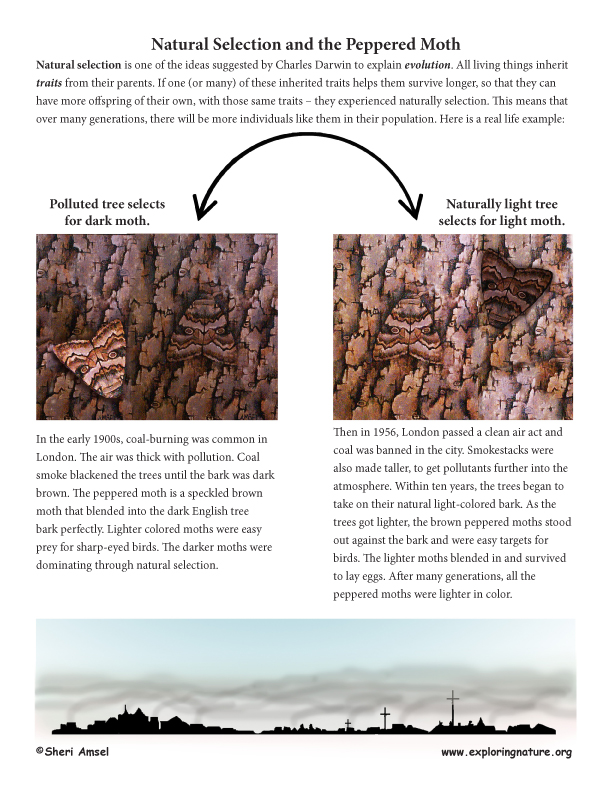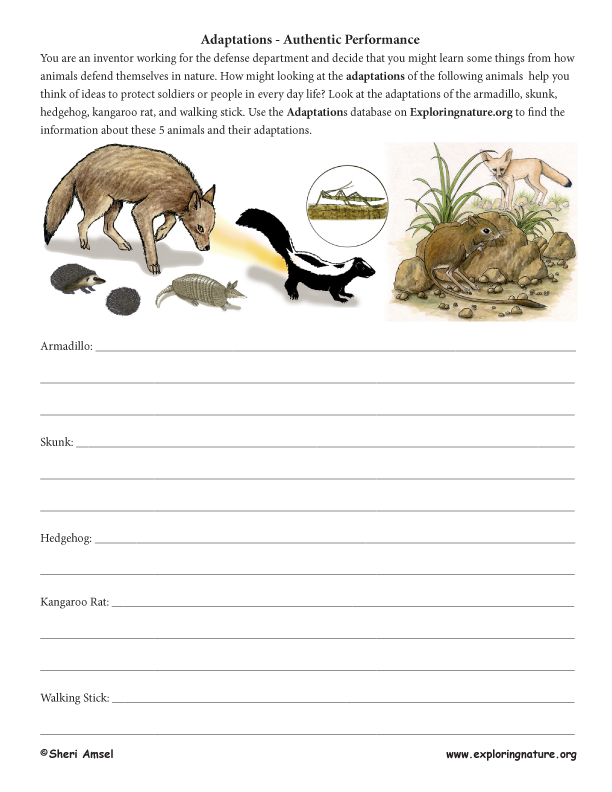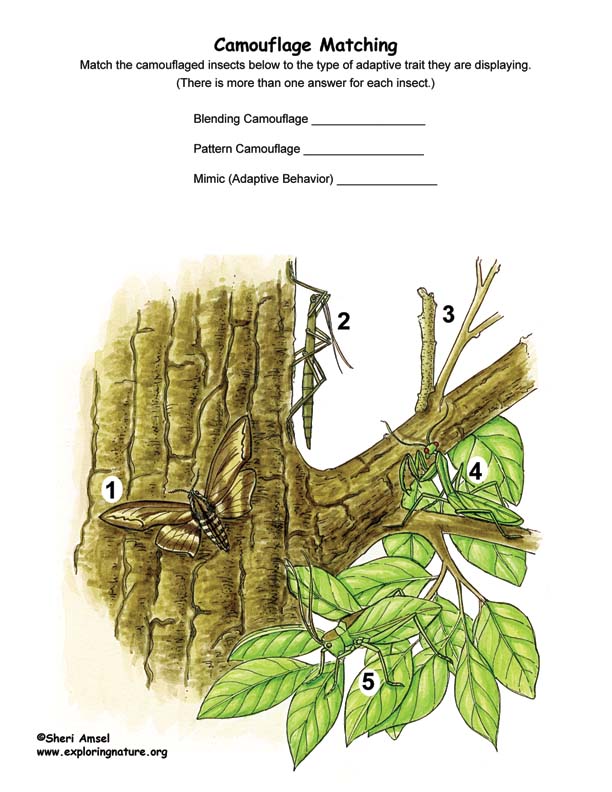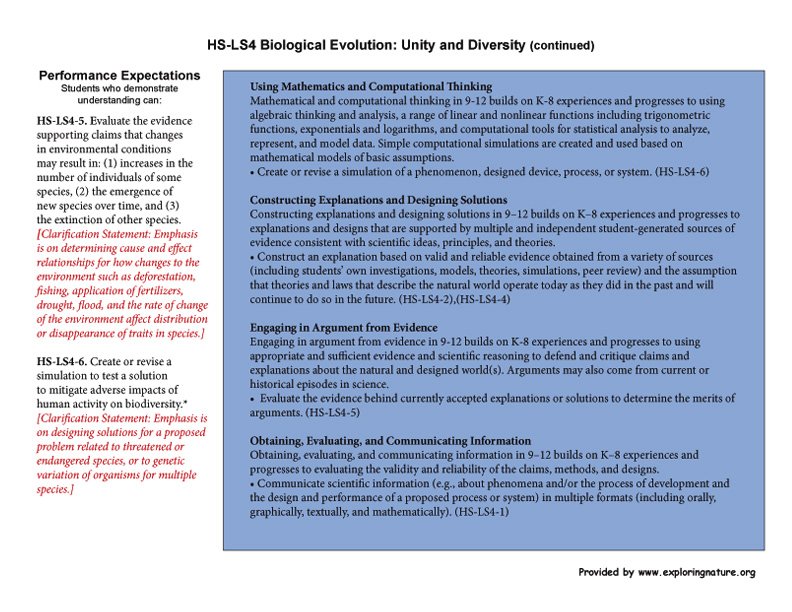

_________________________________________________________________________________________________________________________________________________________
Disciplinary Core Ideas
LS4.A: Evidence of Common Ancestry and Diversity
• Genetic information, like the fossil record, provides evidence of evolution. DNA sequences vary among species, but there are many overlaps; in fact, the ongoing branching that produces multiple lines of descent can be inferred by comparing the DNA sequences of different organisms. Such information is also derivable from the similarities and differences in amino acid sequences and from anatomical and embryological evidence. (HS-LS4-1)
LS4.B: Natural Selection
• Natural selection occurs only if there is both (1) variation in the genetic information between organisms in a population and (2) variation in the expression of that genetic information—that is, trait variation—that leads to differences in performance among individuals. (HS-LS4-2),(HS-LS4-3)
• The traits that positively affect survival are more likely to be reproduced, and thus are more common in the population. (HS-LS4-3)
LS4.C: Adaptation
• Evolution is a consequence of the interaction of four factors: (1) the potential for a species to increase in number, (2) the genetic variation of individuals in a species due to mutation and sexual reproduction, (3) competition for an environment’s limited supply of the resources that individuals need in order to survive and reproduce, and (4) the ensuing proliferation of those organisms that are better able to survive and reproduce in that environment. (HS-LS4-2)
• Natural selection leads to adaptation, that is, to a population dominated by organisms that are anatomically, behaviorally, and physiologically well suited to survive and reproduce in a specific environment. That is, the differential survival and reproduction of organisms in a population that have an advantageous heritable trait leads to an increase in the proportion of individuals in future generations that have the trait and to a decrease in the proportion of individuals that do not. (HS-LS4-3),(HS-LS4-4)
• Adaptation also means that the distribution of traits in a population can change when conditions change. (HS-LS4-3)
• Changes in the physical environment, whether naturally occurring or human induced, have thus contributed to the expansion of some species, the emergence of new distinct species as populations diverge under different conditions, and the decline–and sometimes the extinction–of some species. (HS-LS4-5),(HS-LS4-6)
• Species become extinct because they can no longer survive and reproduce in their altered environment. If members cannot adjust to change that is too fast or drastic, the opportunity for the species’ evolution is lost. (HS-LS4-5)
LS4.D: Biodiversity and Humans
• Humans depend on the living world for the resources and other benefits provided by biodiversity. But human activity is also having adverse impacts on biodiversity through overpopulation, overexploitation, habitat destruction, pollution, introduction of invasive species, and climate change. Thus sustaining biodiversity so that ecosystem functioning and productivity are maintained is essential to supporting and enhancing life on Earth. Sustaining biodiversity also aids humanity by preserving landscapes of recreational or inspirational value. (HS-LS4-6) (Note: This Disciplinary Core Idea is also addressed by HS-LS2-7.)
ETS1.B: Developing Possible Solutions
• When evaluating solutions, it is important to take into account a range of constraints, including cost, safety, reliability, and aesthetics, and to consider social, cultural, and environmental impacts. (secondary to HS-LS4-6)
• Both physical models and computers can be used in various ways to aid in the engineering design process. Computers are useful for a variety of purposes, such as running simulations to test different ways of solving a problem or to see which one is most efficient or economical; and in making a persuasive presentation to a client about how a given design will meet his or her needs. (secondary to HS-LS4-6
_________________________________________________________________________________________________________________________________________________________
Use the Template and Resource Links to Fulfill NGSS
l. Goals:
Essential Questions:
NGSS Note: Think, question, entertain ideas.
ll. Introductory Activities to Assess Prior Knowledge
A. Brainstorming Sessions
Question: What are some examples of natural selection in animal coloring?
1. Break students down into groups of 3-4.
2. Ask students to generate a list of the different animals they know that have adaptive coloring.
3. Discuss
Brainstorming Sessions
Question: What are some examples of artificial selection in animal selective breeding?
1. Break students down into groups of 3-4.
2. Ask students to generate a list of the the animals they know of that have been affected by artificial selection.
3. Discuss
B. Quiz
Endangered Species Multiple Choice
lll. New Knowledge - Text
A. Read about:
Adaptation and Natural Selection (HS)
Bats - Adaptation and Changing Environments - Evaluate Evidence (HS)
Plant Adaptations for Pollination & Seed Dispersal
Natural Selection and the Peppered Moth Activity
The History of Genetics - How Animals Were Domesticated
The History of Genetics - How Wild Plants Were Domesticated
Insect Adaptation - Camouflage Matching
B. Examples of Models (depicts the concept expressed in the reading):
Ask students to look at the models and explain how each illustrates the concepts they've read about.
lV. Experiments, Activities, Model-making (Critical Thinking)
A. Critical Thinking Activities related to adaptation and natural selection:
Natural Selection and the Peppered Moth Activity
Insect Adaptation - Camouflage Matching
Insect Camouflage Matching - Structure & Function
Adaptation in the Schoolyard - Read and React
Animal Adaptation Observation and Critical Thinking
Insect Camouflage Matching - Structure & Function
Pollination and Seed Dispersal Adaptations
B. Authentic Performance - Understanding by Design (UbD) assessment tool.
Use critical thinking to complete thse Authentic Performance Activities and deepen your understanding about the above topics.
Vl. New Generation of Science Standards (NGSS) - High School Life Science
Disciplinary Core Ideas
LS4.A: Evidence of Common Ancestry and Diversity
• Genetic information, like the fossil record, provides evidence of evolution. DNA sequences vary among species, but there are many overlaps; in fact, the ongoing branching that produces multiple lines of descent can be inferred by comparing the DNA sequences of different organisms. Such information is also derivable from the similarities and differences in amino acid sequences and from anatomical and embryological evidence. (HS-LS4-1)
LS4.B: Natural Selection
• Natural selection occurs only if there is both (1) variation in the genetic information between organisms in a population and (2) variation in the expression of that genetic information—that is, trait variation—that leads to differences in performance among individuals. (HS-LS4-2),(HS-LS4-3)
• The traits that positively affect survival are more likely to be reproduced, and thus are more common in the population. (HS-LS4-3)
LS4.C: Adaptation
• Evolution is a consequence of the interaction of four factors: (1) the potential for a species to increase in number, (2) the genetic variation of individuals in a species due to mutation and sexual reproduction, (3) competition for an environment’s limited supply of the resources that individuals need in order to survive and reproduce, and (4) the ensuing proliferation of those organisms that are better able to survive and reproduce in that environment. (HS-LS4-2)
• Natural selection leads to adaptation, that is, to a population dominated by organisms that are anatomically, behaviorally, and physiologically well suited to survive and reproduce in a specific environment. That is, the differential survival and reproduction of organisms in a population that have an advantageous heritable trait leads to an increase in the proportion of individuals in future generations that have the trait and to a decrease in the proportion of individuals that do not. (HS-LS4-3),(HS-LS4-4)
• Adaptation also means that the distribution of traits in a population can change when conditions change. (HS-LS4-3)
• Changes in the physical environment, whether naturally occurring or human induced, have thus contributed to the expansion of some species, the emergence of new distinct species as populations diverge under different conditions, and the decline–and sometimes the extinction–of some species. (HS-LS4-5),(HS-LS4-6)
• Species become extinct because they can no longer survive and reproduce in their altered environment. If members cannot adjust to change that is too fast or drastic, the opportunity for the species’ evolution is lost. (HS-LS4-5)
LS4.D: Biodiversity and Humans
• Humans depend on the living world for the resources and other benefits provided by biodiversity. But human activity is also having adverse impacts on biodiversity through overpopulation, overexploitation, habitat destruction, pollution, introduction of invasive species, and climate change. Thus sustaining biodiversity so that ecosystem functioning and productivity are maintained is essential to supporting and enhancing life on Earth. Sustaining biodiversity also aids humanity by preserving landscapes of recreational or inspirational value. (HS-LS4-6) (Note: This Disciplinary Core Idea is also addressed by HS-LS2-7.)
ETS1.B: Developing Possible Solutions
• When evaluating solutions, it is important to take into account a range of constraints, including cost, safety, reliability, and aesthetics, and to consider social, cultural, and environmental impacts. (secondary to HS-LS4-6)
• Both physical models and computers can be used in various ways to aid in the engineering design process. Computers are useful for a variety of purposes, such as running simulations to test different ways of solving a problem or to see which one is most efficient or economical; and in making a persuasive presentation to a client about how a given design will meet his or her needs. (secondary to HS-LS4-6
Science and Engineering Practices
Analyzing and Interpreting Data
Analyzing data in 9–12 builds on K–8 experiences and progresses to introducing more detailed statistical analysis, the comparison of data sets for consistency, and the use of models to generate and analyze data.
• Apply concepts of statistics and probability (including determining function fits to data, slope, intercept, and correlation coefficient for linear fits) to scientific and engineering questions and problems, using digital tools when feasible. (HS-LS4-3)
Using Mathematics and Computational Thinking
Mathematical and computational thinking in 9-12 builds on K-8 experiences and progresses to using algebraic thinking and analysis, a range of linear and nonlinear functions including trigonometric functions, exponentials and logarithms, and computational tools for statistical analysis to analyze, represent, and model data. Simple computational simulations are created and used based on mathematical models of basic assumptions.
• Create or revise a simulation of a phenomenon, designed device, process, or system. (HS-LS4-6)
Constructing Explanations and Designing Solutions
Constructing explanations and designing solutions in 9–12 builds on K–8 experiences and progresses to explanations and designs that are supported by multiple and independent student-generated sources of evidence consistent with scientific ideas, principles, and theories.
• Construct an explanation based on valid and reliable evidence obtained from a variety of sources (including students’ own investigations, models, theories, simulations, peer review) and the assumption that theories and laws that describe the natural world operate today as they did in the past and will continue to do so in the future. (HS-LS4-2),(HS-LS4-4)
Engaging in Argument from Evidence
Engaging in argument from evidence in 9-12 builds on K-8 experiences and progresses to using appropriate and sufficient evidence and scientific reasoning to defend and critique claims and explanations about the natural and designed world(s). Arguments may also come from current or historical episodes in science.
• Evaluate the evidence behind currently accepted explanations or solutions to determine the merits of arguments. (HS-LS4-5)
Obtaining, Evaluating, and Communicating Information
Obtaining, evaluating, and communicating information in 9–12 builds on K–8 experiences and progresses to evaluating the validity and reliability of the claims, methods, and designs.
• Communicate scientific information (e.g., about phenomena and/or the process of development and the design and performance of a proposed process or system) in multiple formats (including orally, graphically, textually, and mathematically). (HS-LS4-1)
Connections to Nature of Science
Theories Explain Natural Phenomena
• A scientific theory is a substantiated explanation of some aspect of the natural world, based on a body of facts that have been repeatedly confirmed through observation and experiment and the science community validates each theory before it is accepted. If new evidence is discovered that the theory does not accommodate, the theory is generally modified in light of this new evidence. (HS-LS4-1)
Crosscutting Concepts (NGSS)
Patterns
• Different patterns may be observed at each of the scales at which a system is studied and can provide evidence for causality in explanations of phenomena. (HS-LS4-1),(HS-LS4-3)
Cause and Effect
• Empirical evidence is required to differentiate between cause and correlation and make claims about specific causes and effects. (HS-LS4-2),(HS-LS4-4),(HS-LS4-5),(HS-LS4-6)
Connections to Nature of Science
Scientific Knowledge Assumes an Order and Consistency in Natural Systems
• Scientific knowledge is based on the assumption that natural laws operate today as they did in the past and they will continue to do so in the future. (HS-LS4-1),(HS-LS4-4)
Performance Expectations
Students who demonstrate understanding can:
HS-LS4-1. Communicate scientific information that common ancestry and biological evolution are supported by multiple lines of empirical evidence. [Clarification Statement: Emphasis is on a conceptual understanding of the role each line of evidence has relating to common ancestry and biological evolution. Examples of evidence could include similarities in DNA sequences, anatomical structures, and order of appearance of structures in embryological development.]
HS-LS4-2. Construct an explanation based on evidence that the process of evolution primarily results from four factors: (1) the potential for a species to increase in number, (2) the heritable genetic variation of individuals in a species due to mutation and sexual reproduction, (3) competition for limited resources, and (4) the proliferation of those organisms that are better able to survive and reproduce in the environment. [Clarification Statement: Emphasis is on using evidence to explain the influence each of the four factors has on number of organisms, behaviors, morphology, or physiology in terms of ability to compete for limited resources and subsequent survival of individuals and adaptation of species. Examples of evidence could include mathematical models such as simple distribution graphs and proportional reasoning.] [Assessment Boundary: Assessment does not include other mechanisms of evolution, such as genetic drift, gene flow through migration, and co-evolution.]
HS-LS4-3. Apply concepts of statistics and probability to support explanations that organisms with an advantageous heritable trait tend to increase in proportion to organisms lacking this trait. [Clarification Statement: Emphasis is on analyzing shifts in numerical distribution of traits and using these shifts as evidence to support explanations.] [Assessment Boundary: Assessment is limited to basic statistical and graphical analysis. Assessment does not include allele frequency calculations.]
HS-LS4-4. Construct an explanation based on evidence for how natural selection leads to adaptation of populations. [Clarification Statement: Emphasis is on using data to provide evidence for how specific biotic and abiotic differences in ecosystems (such as ranges of seasonal temperature, long-term climate change, acidity, light, geographic barriers, or evolution of other organisms) contribute to a change in gene frequency over time, leading to adaptation of populations.]
HS-LS4-5. Evaluate the evidence supporting claims that changes in environmental conditions may result in: (1) increases in the number of individuals of some species, (2) the emergence of new species over time, and (3) the extinction of other species. [Clarification Statement: Emphasis is on determining cause and effect relationships for how changes to the environment such as deforestation, fishing, application of fertilizers, drought, flood, and the rate of change of the environment affect distribution or disappearance of traits in species.]
HS-LS4-6. Create or revise a simulation to test a solution to mitigate adverse impacts of human activity on biodiversity.* [Clarification Statement: Emphasis is on designing solutions for a proposed problem related to threatened or endangered species, or to genetic variation of organisms for multiple species.]
Common Core State Standards Connections
ELA/Literacy
RST-11.12.1 Cite specific textual evidence to support analysis of science and technical texts, attending to important distinctions the author makes and to any gaps or inconsistencies in the account. (HS-LS4-1),(HS-LS4-2),(HS-LS4-3),(HS-LS4-4)
RST-11.12.8 Evaluate the hypotheses, data, analysis, and conclusions in a science or technical text, verifying the data when possible and corroborating or challenging conclusions with other sources of information. (HS-LS4-5)
WHST.9-12.2 Write informative/explanatory texts, including the narration of historical events, scientific procedures/ experiments, or technical processes. (HS-LS4-1),(HS-LS4-2),(HS-LS4-3),(HS-LS4-4)
WHST.9-12.5 Develop and strengthen writing as needed by planning, revising, editing, rewriting, or trying a new approach, focusing on addressing what is most significant for a specific purpose and audience. (HS-LS4-6)
WHST.9-12.7 Conduct short as well as more sustained research projects to answer a question (including a self-generated question) or solve a problem; narrow or broaden the inquiry when appropriate; synthesize multiple sources on the subject, demonstrating understanding of the subject under investigation. (HS-LS4-6)
WHST.9-12.9 Draw evidence from informational texts to support analysis, reflection, and research. (HS-LS4-1),(HS-LS4-2),(HS-LS4-3),(HS-LS4-4),(HS-LS4-5)
SL.11-12.4 Present claims and findings, emphasizing salient points in a focused, coherent manner with relevant evidence, sound valid reasoning, and well-chosen details; use appropriate eye contact, adequate volume, and clear pronunciation. (HS-LS4-1),(HS-LS4-2)
Mathematics -
MP.2 Reason abstractly and quantitatively. (HS-LS4-1),(HS-LS4-2),(HS-LS4-3),(HS-LS4-4),(HS-LS4-5)
MP.4 Model with mathematics. (HS-LS4-2)
When you research information you must cite the reference. Citing for websites is different from citing from books, magazines and periodicals. The style of citing shown here is from the MLA Style Citations (Modern Language Association).
When citing a WEBSITE the general format is as follows.
Author Last Name, First Name(s). "Title: Subtitle of Part of Web Page, if appropriate." Title: Subtitle: Section of Page if appropriate. Sponsoring/Publishing Agency, If Given. Additional significant descriptive information. Date of Electronic Publication or other Date, such as Last Updated. Day Month Year of access < URL >.
Amsel, Sheri. "Grade 9-12 - HS-LS4 Biological Evolution: Unity and Diversity" Exploring Nature Educational Resource ©2005-2024. December 13, 2024
< http://www.exploringnature.org/db/view/Grade-9-12-HS-LS4-Biological-Evolution-Unity-and-Diversity >







